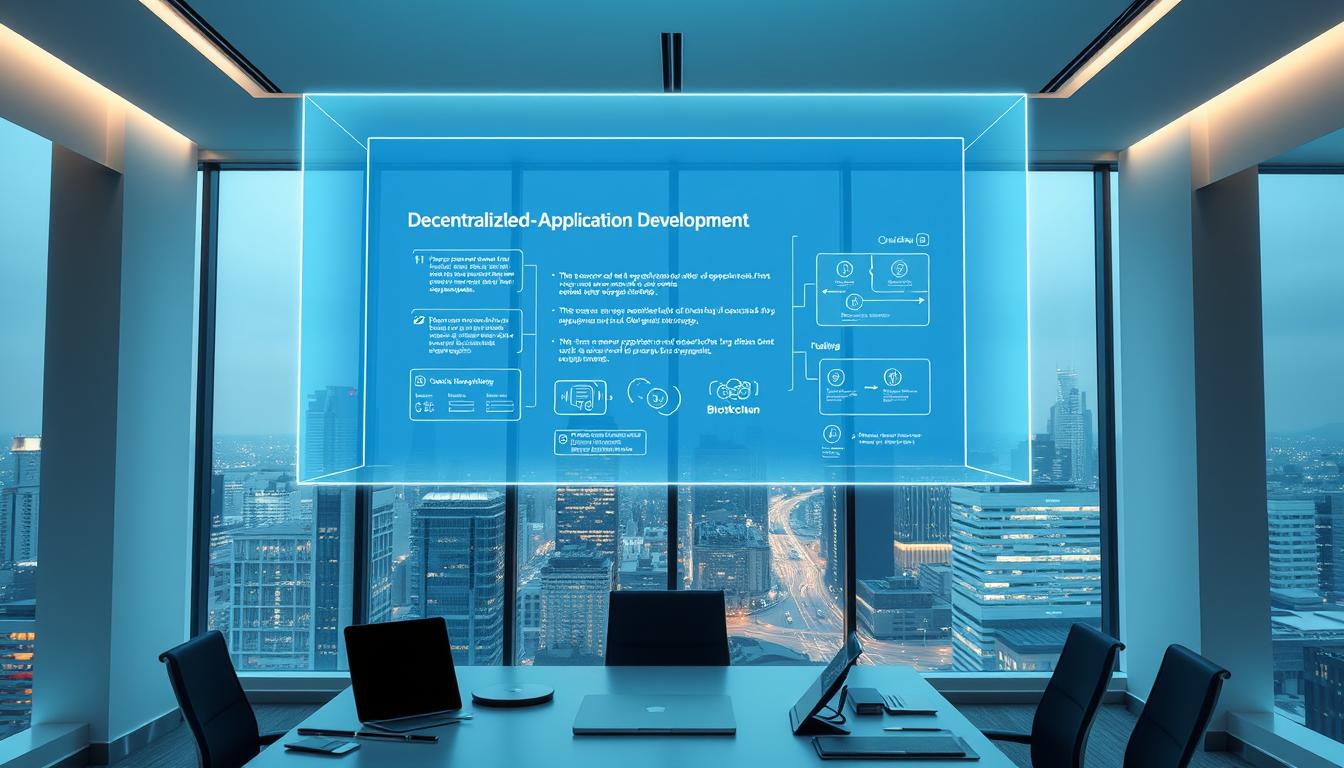Now Reading: Integrating AI and Blockchain: Unlocking the Future’s Potential
- 01
Integrating AI and Blockchain: Unlocking the Future’s Potential
Integrating AI and Blockchain: Unlocking the Future’s Potential

Two groundbreaking innovations are reshaping how industries operate: advanced analytics systems and decentralized ledgers. When combined, they create a powerful framework for solving complex challenges. This integration merges secure, tamper-proof record-keeping with adaptive learning tools, forming a foundation for smarter, more transparent systems.
Decentralized ledgers excel at storing information securely, while smart algorithms analyze patterns to drive decisions. Together, they address critical gaps in modern infrastructure. For example, unlocking new possibilities through integration allows organizations to maintain audit trails while automating high-stakes processes.
Adopting these combined solutions isn’t without hurdles. Technical teams must reconcile differing architectures and evolving protocols. Standards for cross-platform compatibility remain in flux, requiring careful planning. However, early adopters report measurable gains in operational trust and efficiency.
Forward-thinking enterprises recognize this synergy as a strategic priority. By pairing immutable data storage with predictive capabilities, businesses future-proof their workflows. The result? A competitive edge built on transparency, accuracy, and adaptability.
Key Takeaways
- Combining decentralized ledgers with adaptive systems enhances security and decision-making
- Immutable record-keeping ensures reliable data for analytical models
- Interoperability standards remain critical for seamless technology merging
- Early integration efforts show improved auditability across supply chains
- Strategic adoption positions organizations for emerging industry demands
Overview of AI and Blockchain Synergy
Modern enterprises face unprecedented challenges requiring dual innovations. Smart analytical tools now merge with secure ledgers, creating systems that boost both security and efficiency. This pairing solves critical issues like data integrity and decision accuracy.
Market Momentum Accelerates
Recent projections reveal staggering adoption rates. Over half of U.S. companies plan to implement combined solutions by year-end. Financial analysts predict:
| Year | Market Size | CAGR | Key Driver |
|---|---|---|---|
| 2027 | $27B | 60% | Supply chain upgrades |
| 2033 | $3.7B | 34% | Healthcare applications |
| 2024 | $980M | – | Early adopters |
Core Innovation Catalysts
Three factors propel this convergence:
- Demand for tamper-proof data storage
- Need for transparent decision trails
- Automated verification processes
Industry leaders report 85% agreement that merged technologies outperform standalone tools. Financial institutions lead adoption, using combined systems for fraud detection and risk modeling. As platforms mature, organizations gain tools to handle complex data relationships securely.
The Evolution of AI and Blockchain Convergence
Digital innovation timelines reveal a fascinating pattern: complementary technologies often accelerate each other’s maturation. This dynamic drives today’s rapid fusion of decentralized ledgers and smart analytical tools.
Historical Milestones and Industry Shifts
Early experiments in 2018 laid groundwork for practical implementations. NFT platforms became unexpected pioneers, employing pattern recognition for digital art authentication. By 2021, automated contract creation reached critical mass – over 10,000 agreements generated without human input.
Recent ClearBridge data shows 72% of manufacturers now test combined solutions. Healthcare networks adopt these systems for secure patient records, while logistics firms achieve 40% faster customs clearance. The table below highlights pivotal moments:
| Year | Milestone | Industry Impact |
|---|---|---|
| 2018 | First hybrid prototypes | Proved technical feasibility |
| 2020 | Decentralized AI platforms | Enabled distributed model training |
| 2022 | Enterprise adoption surge | Mainstream operational integration |
| 2024 | Hedera healthcare deployments | Reduced admin costs by 33% |
This progression demonstrates shifting perspectives. Organizations no longer view these tools as rivals, but as collaborative partners. AI-enhanced security protocols now complement distributed ledgers, creating robust verification layers.
Current development cycles produce breakthroughs monthly rather than annually. As platforms mature, they enable smarter supply chains and transparent governance models – proving that technological synergy drives real-world transformation.
Artificial intelligence blockchain integration use cases and future applications
Organizations now deploy cutting-edge systems that merge smart analytics with distributed ledgers. These combinations address critical operational needs while building trust through verifiable processes.

Diverse Industry Implementations
Practical deployments reveal tangible benefits across sectors:
| Industry | Implementation | Impact |
|---|---|---|
| Healthcare | Encrypted patient records + diagnostic algorithms | 38% faster treatment plans |
| Retail | Fraud detection systems + transaction ledgers | 62% fewer chargebacks |
| Finance | Automated compliance checks + audit trails | 90% faster regulatory reporting |
| Government | Voter ID verification + predictive turnout models | 99.7% election accuracy |
| Logistics | Smart contracts + route optimization | 29% fuel cost reduction |
Future Development Opportunities
Emerging concepts push boundaries beyond current capabilities. Vehicle-to-grid networks could leverage secure decentralized frameworks for energy trading, while smart city ecosystems might automate utility management through self-learning grids.
Environmental sectors show particular promise. Distributed ledgers track carbon credits while analytical models predict emission hotspots. This synergy enables actionable sustainability strategies with measurable outcomes.
Enhancing Data Privacy and Security in Digital Environments
Protecting sensitive information has become critical as digital systems expand. Centralized databases struggle with rising cyber threats, creating urgent demand for robust solutions. New approaches now shift control from institutions to individuals through innovative architectures.

Decentralized Data Control Mechanisms
Distributed ledger systems transform how organizations handle sensitive records. By spreading information across multiple nodes, these frameworks eliminate single failure points. This structure makes mass breaches nearly impossible – hackers would need to compromise entire networks simultaneously.
Users now dictate precise sharing rules for their personal data. Granular permissions determine what details become accessible, to whom, and for how long. A healthcare provider might grant temporary access to test results while blocking insurance details.
Platforms like Ocean Protocol demonstrate this shift. Medical researchers can analyze encrypted patient records without viewing identifiable information. Smart contracts automatically enforce privacy terms while enabling valuable insights.
Three key advantages emerge:
- Immutable audit trails track every data interaction
- Cryptographic protection layers exceed traditional security
- Real-time revocation of access rights
Financial institutions report 73% fewer unauthorized access attempts after adopting these models. As digital ecosystems grow, decentralized control becomes essential for maintaining trust and compliance.
Decentralizing AI Model Training and Deployment
Collaborative approaches are redefining how machine learning evolves. Traditional methods often silo development within single organizations, limiting access to diverse datasets. New frameworks now enable collective progress while preserving data privacy.

Token-Based Incentives for Collaboration
Distributed ledgers introduce fair compensation models for contributors. Participants earn digital tokens when sharing computing power or anonymized datasets. This system rewards quality inputs – better resources yield higher returns.
Smart contracts automate payouts based on predefined metrics. A model’s accuracy improvements or processing speed might trigger rewards. This transparency builds trust among collaborators from competing firms.
Collaborative Learning Frameworks
Secure data sharing protocols let organizations pool insights without exposing raw information. Hospitals could jointly develop diagnostic tools while keeping patient records encrypted. Each contributor maintains full control over their proprietary assets.
These frameworks produce more adaptable machine learning systems. Models trained on global shipping patterns and regional weather data outperform single-source versions. Diversity in training materials reduces bias and improves real-world performance.
Key advantages include:
- Elimination of centralized infrastructure costs
- Automatic quality checks through multi-party validation
- Faster iteration cycles from shared improvements
Early adopters in pharmaceutical research cut development timelines by 41% using this approach. As blockchain matures, decentralized training could become the standard for ethical, efficient AI development.
Transforming Supply Chain Management with Blockchain
Global trade networks face mounting pressure to deliver goods faster while maintaining ethical standards. Modern tracking systems now address these demands through verifiable record-keeping and automated decision tools.
End-to-End Traceability Solutions
Every product movement gets logged across distributed networks, creating permanent histories. Farmers to retailers access shipment details instantly, from temperature logs to customs approvals. This visibility slashes counterfeit risks by 89% in pilot programs.

Pharmaceutical companies now track vaccines using this approach. Each vial’s journey appears in real-time dashboards, with alerts for deviations. Stakeholders verify authenticity before distribution, protecting public health.
Predictive Analytics in Logistics
Advanced algorithms analyze shipment patterns using historical ledger data. Retailers anticipate regional demand spikes weeks earlier, adjusting stock levels proactively. This prevents overproduction waste while meeting customer needs.
| Industry | Implementation | Result |
|---|---|---|
| Automotive | Parts origin verification | 73% faster recalls |
| Agriculture | Harvest-to-store tracking | 41% less spoilage |
| Apparel | Labor compliance checks | 98% ethical sourcing |
Smart agreements trigger payments automatically when goods reach checkpoints. Shipping firms report 22% fewer delays since adopting these systems. As networks expand, collaborative ecosystems form – competitors share logistics data securely while protecting trade secrets.
Building Transparent and Ethical AI Systems
Rising ethical questions in tech demand solutions that balance innovation with accountability. Combining distributed ledger capabilities with advanced analytics creates frameworks where decisions become explainable and fair. This approach transforms opaque processes into verifiable workflows, addressing core concerns about automated decision-making.
Audit Trails for Responsible Development
Blockchain technology provides permanent records of how data shapes analytical models. Every training input and algorithm adjustment gets timestamped, allowing teams to trace potential biases. Developers can pinpoint skewed assumptions by reviewing these immutable histories.
Smart contracts automate compliance checks during model creation. Microsoft Azure’s distributed ledger tools enforce ethical guidelines by design, requiring diversity audits before deployment. Transparency becomes operational rather than aspirational.
Third-party validators now use these systems to certify fairness standards. Organizations share verification results publicly, building user trust. This shift moves ethical development from afterthought to core requirement.











